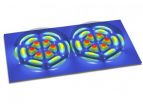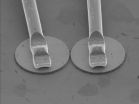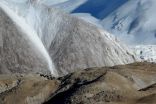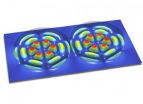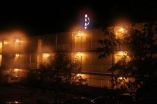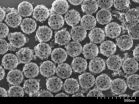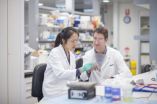(Press-News.org) Inspired by anomalies that arise in certain mathematical equations, researchers have demonstrated a laser system that paradoxically turns off when more power is added rather than becoming continuously brighter.
The finding by a team of researchers at Vienna University of Technology and Princeton University, could lead to new ways to manipulate the interaction of electronics and light, an important tool in modern communications networks and high-speed information processing.
The researchers published their results June 13 in the journal Nature Communications (Ref. 1).
Their system involves two tiny lasers, each one-tenth of a millimeter in diameter, or about the width of a human hair. The two are nearly touching, separated by a distance 50 times smaller than the lasers themselves. One is pumped with electric current until it starts to emit light, as is normal for lasers. Power is then added slowly to the other, but instead of it also turning on and emitting even more light, the whole system shuts off.
"This is not the normal interference that we know," said Hakan Türeci, assistant professor of electrical engineering at Princeton, referring to the common phenomenon of light waves or sound waves from two sources cancelling each other. Instead, he said, the cancellation arises from the careful distribution of energy loss within an overall system that is being amplified.
"Loss is something you normally are trying to avoid," Türeci said. "In this case, we take advantage of it and it gives us a different dimension we can use – a new tool – in controlling optical systems."
The research grows out of Türeci's longstanding work on mathematical models that describe the behavior of lasers. In 2008 (Ref. 2), he established a mathematical framework for understanding the unique properties and complex interactions that are possible in extremely small lasers – devices with features measured in micrometers or nanometers. Different from conventional desk-top lasers, these devices fit on a computer chip.
That work opened the door to manipulating gain or loss (the amplification or loss of an energy input) within a laser system. In particular, it allowed researchers to judiciously control the spatial distribution of gain and loss within a single system, with one tiny sub-area amplifying light and an immediately adjacent area absorbing the generated light.
Türeci and his collaborators are now using similar ideas to pursue counterintuitive ideas for using distribution of gain and loss to make micro-lasers more efficient.
The researchers' ideas for taking advantage of loss derive from their study of mathematical constructs called "non-Hermitian" matrices in which a normally symmetric table of values becomes asymmetric. Türeci said the work is related to certain ideas of quantum physics in which the fundamental symmetries of time and space in nature can break down even though the equations used to describe the system continue to maintain perfect symmetry.
Over the past several years, Türeci and his collaborators at Vienna worked to show how the mathematical anomalies at the heart of this work, called "exceptional points," could be manifested in an actual system. In 2012 (Ref. 3), the team published a paper in the journal Physical Review Letters demonstrating computer simulations of a laser system that shuts off as energy is being added. In the current Nature Communications paper, the researchers created an experimental realization of their theory using a light source known as a quantum cascade laser.
The researchers report in the article that results could be of particular value in creating "lab-on-a-chip" devices – instruments that pack tiny optical devices onto a single computer chip. Understanding how multiple optical devices interact could provide ways to manipulate their performance electronically in previously unforeseen ways. Taking advantage of the way loss and gain are distributed within tightly coupled laser systems could lead to new types of highly accurate sensors, the researchers said.
"Our approach provides a whole new set of levers to create unforeseen and useful behaviors," Türeci said.
The work at Vienna, including creation and demonstration of the actual device, was led by Stefan Rotter at Vienna along with Martin Brandstetter, Matthias Liertzer, C. Deutsch, P. Klang, J. Schöberl, G. Strasser and K. Unterrainer. Türeci participated in the development of the mathematical models underlying the phenomena. The work on the 2012 computer simulation of the system also included Li Ge, who was a post-doctoral researcher at Princeton at the time and is now an assistant professor at City University of New York.
INFORMATION:
The work was supported in part by the National Science Foundation through a major grant for the Mid-Infrared Technologies for Health and the Environment Center based at Princeton and by the Defense Advanced Research Projects Agency.
A news release from the Vienna University of Technology is available here: http://www.tuwien.ac.at/en/news/news_detail/article/8851/.
Ref. 1
Nature Communications 13 June 2014. DOI:10.1038/ncomms5034
Ref. 2
Science 2 May 2008. DOI: 10.1126/science.1155311
Ref. 3
Physical Review Letters 24 April 2012. DOI:10.1103/PhysRevLett.108.173901
Strange physics turns off laser
2014-06-17
ELSE PRESS RELEASES FROM THIS DATE:
Study: In wild yak society, moms are the real climbers
2014-06-17
NEW YORK (June 17, 2014) – A new study led by the Wildlife Conservation Society says that in wild yak societies, it's the mothers that are the real climbers. The study found that mothers with young venture on steeper terrain and slightly higher elevation than either males or females without young.
The authors of the study expect that this strategy is an adaptive way to avoid predators and to access more nutritious food. Wild yaks are an endangered species occurring only on the Tibetan Plateau and closely related to North American bison.
The study, which appears in ...
Promising T cell therapy
2014-06-17
This news release is available in German. The cells of the human immune system are created from special stem cells in the bone marrow. In diseases affecting the bone marrow, such as leukemia, the degenerate cells must be destroyed using radiation or chemotherapy. Subsequently, the hematopoietic system has to be replaced with stem cells from the blood of a healthy donor. Because of the resulting temporary weakening of the immune system, patients are more exposed to viruses that would normally be warded off.
The cytomegalovirus (CMV), which can cause serious damage to ...
Laser physics upside down
2014-06-17
This news release is available in German.
Sound waves fade, water waves ebb, light waves are dissipated by a wall. The absorption of waves is a very common phenomenon. But only recently have physicists realized that amazing new possibilities are opened up, when this energy loss, rather than being seen as an annoying nuisance, is actually considered a desired effect. At the Vienna University of Technology, a system of two coupled lasers has been created, in which wave dissipation leads to a behaviour completely contrary to intuition: additional energy can switch it ...
Research at Granada finds that the eye's optical quality deteriorates after alcohol consumption
2014-06-17
A study conducted by the University of Granada has scientifically proven that alcohol consumption markedly impairs night-vision because it increases the perception of halos—luminous circles—and other visual night-time disturbances. Moreover, this deterioration of vision is significantly greater in subjects with breath alcohol content in excess of 0.25mg/litre—the legal limit for driving in Spain and other countries and, also, that recommended by the World Health Organization (WHO).
Researchers from the Laboratory of Vision Sciences and Applications conclude that alcohol ...
Does the moon affect our sleep?
2014-06-17
Popular beliefs about the influence of the moon on humans widely exist. Many people report sleeplessness around the time of full moon. In contrast to earlier studies, scientists from the Max Planck Institute of Psychiatry in Munich did not observe any correlation between human sleep and the lunar phases. The researchers analyzed preexisting data of a large cohort of volunteers and their sleep nights. Further identification of mostly unpublished null findings suggests that the conflicting results of previous studies might be due to a publication bias.
For centuries, people ...
How does a tree know it's time to grow again?
2014-06-17
Winter takes its toll on living things. To protect themselves from the elements, bears hibernate, and trees go dormant. Biologists have observed what happens when trees become dormant, but up to now, they haven't understood the underlying genetic mechanisms that enable them to start growing again.
Led by molecular geneticists from Michigan Technological University a gene has been identified and characterized that tells a poplar tree when winter ends and a spring growing season begins. Victor Busov, a professor in Michigan Tech's School of Forest Resources and Environmental ...
Long-term study suggests ways to help children learn language and develop cognitive skills
2014-06-17
Examining factors such as how much children gesture at an early age may make it possible to identify and intervene with very young children at risk for delays in speech and cognitive development, according to a new study by researchers at the University of Chicago.
The research by leading early learning scientists looked at children from a wide variety of backgrounds, including those from advantaged and disadvantaged families, and those who had suffered brain injury. Their work was published in an article, "New Evidence About Language and Cognitive Development Based on ...
Nanoshell shields foreign enzymes used to starve cancer cells from immune system
2014-06-17
Nanoengineers at the University of California, San Diego have developed a nanoshell to protect foreign enzymes used to starve cancer cells as part of chemotherapy. Their work is featured on the June 2014 cover of the journal Nano Letters.
Enzymes are naturally smart machines that are responsible for many complex functions and chemical reactions in biology. However, despite their huge potential, their use in medicine has been limited by the immune system, which is designed to attack foreign intruders. For example, doctors have long relied on an enzyme called asparaginase ...
Gene 'switch' reverses cancer in common childhood leukaemia
2014-06-17
Melbourne researchers have shown a type of leukaemia can be successfully 'reversed' by coaxing the cancer cells back into normal development.
The discovery was made using a model of B-progenitor acute lymphoblastic leukaemia (B-ALL), the most common cancer affecting children.
Researchers from the Walter and Eliza Hall Institute showed that switching off a gene called Pax5 could cause cancer in a model of B-ALL, while restoring its function could 'cure' the disease.
Institute researchers Dr Ross Dickins and Ms Grace Liu led the study with institute colleagues and ...
E-cigs heavily marketed on Twitter, study finds
2014-06-17
E-cigarettes, also known as vaping pens or e-hookas, are commonly advertised on Twitter and the tweets often link to commercial websites promoting e-cig use, according to University of Illinois at Chicago researchers.
The study, published as a special supplement in the July 2014 issue of Tobacco Control released online June 16, has implications for future FDA regulations on the marketing of e-cigarettes and related products.
"There's this whole wild west of social media platforms – Facebook, Twitter and Instagram – and the FDA has no way to track what's happening in ...
